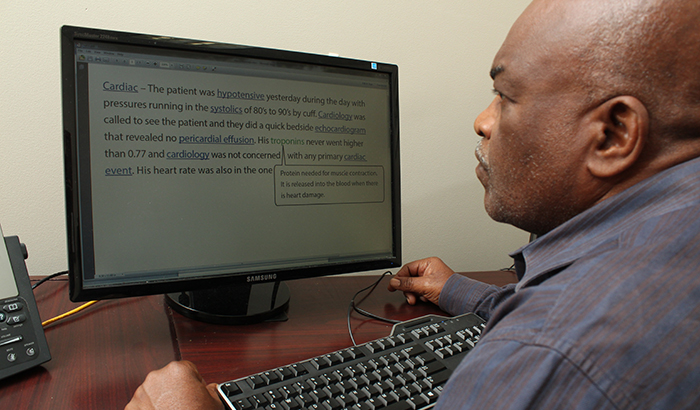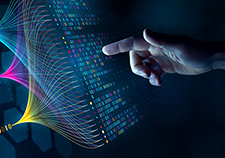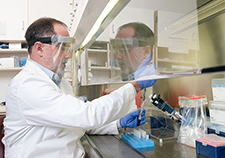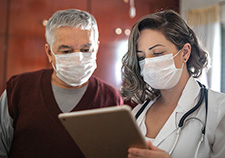Office of Research & Development |
 |


The NoteAid program, still in development by VA researchers, automatically simplifies medical jargon so patients can better understand the clinician notes they view through online portals. (Photo by Mitch Mirkin, for illustrative purposes only)
September 14, 2017
By Mike Richman
VA Research Communications
Researchers have created an online resource that helps patients better understand their health care providers’ electronic medical notes, which are often written in ways that make them difficult for the average person to comprehend.
A research team led by Dr. Hong Yu of the Edith Nourse Rogers Memorial Veterans Hospital in Massachusetts developed NoteAid, which is in the experimental phase. The biomedical natural language processing system recognizes medical jargon and links it with consumer-oriented, simplified definitions from external resources.
"I have a Ph.D., but I am not a physician, and I don't understand a lot of clinical concepts myself. NoteAid would be enormously useful even to me!"
Veterans have access to their electronic health record (EHR) notes through VA’s web-based patient portal system, My HealtheVet. To use NoteAid, patients would put information from their EHR notes into an online box and click “Simplify,” according to a prototype of the software. The same information pops up but with highlighted words that are explained in simple terms when one puts a mouse over the highlighted language.
For example, in a sentence that reads, “The patient will be scheduled for a repeat EGD in one year for surveillance purposes of Barrett’s esophagus,” NoteAid defines an EGD as a “procedure to find and treat problems in the throat, stomach, and the first part of the small intestine.” Barrett’s esophagus, according to NoteAid, is “damage to the lower portion of the tube that connects the mouth and stomach.”
Yu says it is critical that patients be able to understand their medical notes. She refers to the Chronic Care Model (CCM), a guide to higher-quality chronic illness management within primary care. CCM emphasizes that patients are integral to a health care team and that they must have the knowledge, motivation, and skills to participate in their own care. NoteAid will assist in that regard, she says.
“NoteAid can enhance the processing of information within electronic health records,” Yu says. “Information processing models suggest that if knowledge is understood, agreed with, and retained, it can lead to a behavior change in patients, who can comprehend more about their medical status. A behavior change in patients can have a direct impact on physicians. According to CCM, this knowledge can transfer into motivation and skills through enhanced patient-clinical team communication, leading to a situation where patients are more actively engaged in their health care.”
Studies have shown that a patient’s ability to access electronic health records may improve his or her medical understanding and provide clinically relevant benefits.
However, EHR notes are often filled with convoluted terms and phrases, acronyms, complex medication and disease names, and other domain-specific jargon that are difficult for a lay audience to understand. Many patients are thus stifled in their efforts to make the most of their medical records.
A patient’s ability to comprehend clinical notes is related to health literacy. In a 2004 report, the Institute of Medicine (now the National Academy of Medicine) defined health literacy as “the degree to which individuals can obtain, process, and understand the basic health information and services they need to make appropriate health decisions.” The report said 90 million people–nearly half of all American adults–have trouble understanding and acting on health information.
Yu and her team thus created NoteAid. The initial system, developed in 2013, linked medical jargon to external online information sources such as the Unified Medical Language System, MedLinePlus, and Wikipedia. After interviewing patients, the researchers realized that many definitions in these sources were still too complex for patients to understand. Therefore, the team has been manually creating a glossary of lay definitions with a fourth- to seventh-grade readability level. Students from the University of Massachusetts medical school are helping build the glossary. A physician reviews all of the terms for clinical accuracy.

AI to Maximize Treatment for Veterans with Head and Neck Cancer

VA Further Develops Its Central Biorepository: VA SHIELD

VA Launches Scott Hannon Initiative for Precision Mental Health
Thus far, Yu’s team has defined more than 10,000 medical terms for use in NoteAid and is aiming for 100,000, she says.
Yu explains that NoteAid is still in the research phase and is not in use at any VA facilities. But she believes the tool is ready for implementation and hopes it will ultimately benefit Veterans who use My HealtheVet. The portal system provides access to patient health information, links to federal and VA resources, a personal health record, and forms for VA prescription refills.
“We have interviewed Veterans, and every one of them loves NoteAid and hopes to use it,” Yu says.
Dr. Kim Nazi is a senior analyst for VA’s Veterans and Consumers Health Informatics Office, which oversees My HealtheVet. She says she and her colleagues recently saw a demonstration of NoteAid, calling it a “novel tool with great value.”
“We were excited to see a demonstration of the tool that Dr. Yu and her team are developing,” Nazi says. “Since we are a national enterprise system, we do not integrate features that are in the research phase. But we are closely watching as the research progresses, and we are continuing to collaborate with Dr. Yu and her team. Research is a crucial part of our evaluation program and can also identify innovative strategies that can enhance the patient experience.”
Yu and her colleagues learned through a pilot study that NoteAid has the potential to improve electronic health record comprehension, but that more work needs to be done. In the study, published online in 2013 in Studies in Health Technology and Informatics, the researchers selected two groups of people to indicate how well they understood two EHR categories: progress notes and discharge summaries.
They asked one group with non-defined EHR notes to score how hard it would be to understand the notes, with one being the most difficult comprehension and five being the easiest. They gave EHR notes in which NoteAid was implemented to a second group and asked them to provide a comprehension score on the same scale.
Nearly all of the 59 people in the study had some level of college education.
NoteAid linked to four systems to define complicated terms and phrases: Wikipedia, a web-based encyclopedia that has become an important medical resource for many audiences including healthcare professionals; the Unified Medical Language System (UMLS), a biomedical knowledge resource that contains key terms, classifications, and coding standards; MedLine Plus, a source run by the National Library of Medicine that provides information on more than 900 diseases, conditions and treatments; and a hybrid that used a combination of resources.
The researchers found that three of the four systems– Wikipedia, UMLS, and the hybrid–improved comprehension of the progress notes and discharge summaries. However, none of the improvement was “statistically significant,” except for a .71 increase in Wikipedia for progress notes. MedLine Plus did not improve comprehension in either category.
Yu and her team have since been simplifying the definitions. She says more content is needed if the online tool is going to benefit every Veteran who needs to access it. The team has also been making the software more versatile so, for example, it can retrieve a greater volume of relevant information.
Yu believes NoteAid is unique. She doesn’t know of anyone in the private sector who has created a similar technology. But she says more funding is needed to carry the project forward.
“I expect that a majority of patients would use it,” Yu says. “I have a Ph.D., but I am not a physician, and I don’t understand a lot of clinical concepts myself. NoteAid would be enormously useful even to me!”
VA Research Currents archives || Sign up for VA Research updates